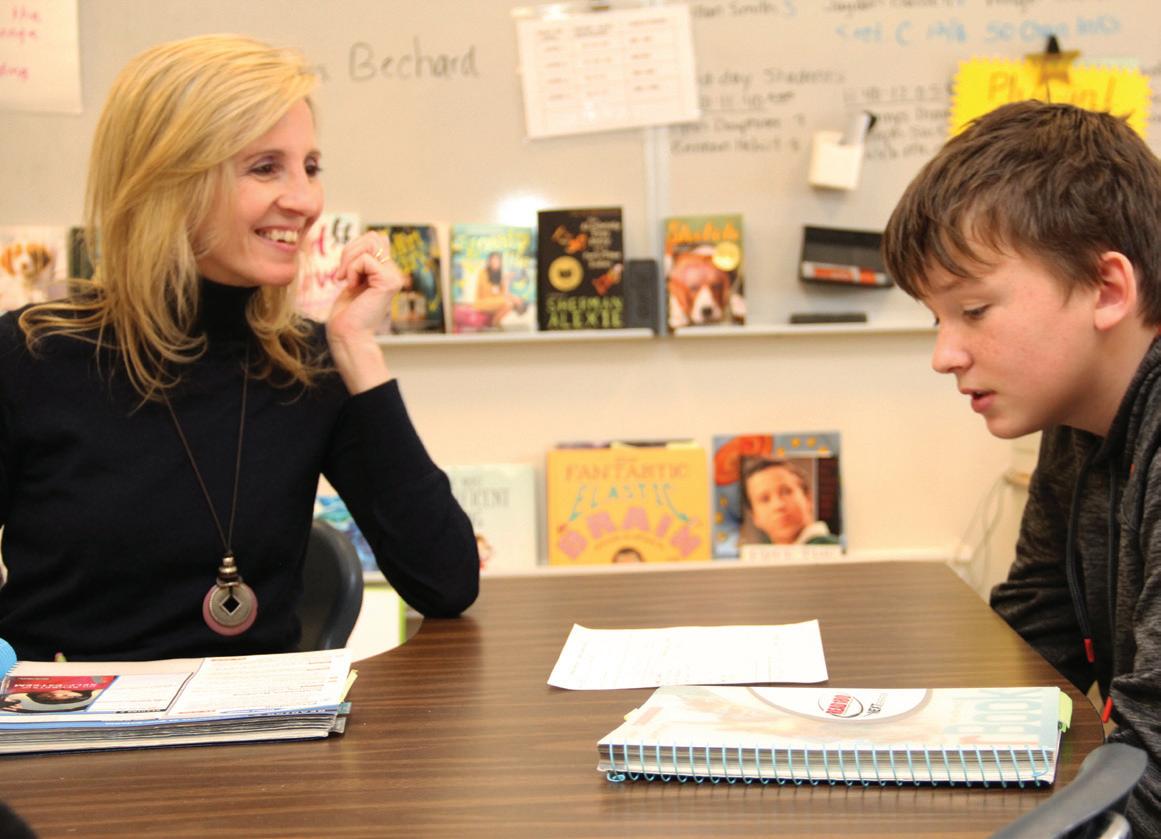
6 minute read
Educator Recommended Books
NEA’S READ ACROSS AMERICA Educator Recommended Books 2016-2017
PreK-K
Maybe Something Beautiful: How Art Transformed a Neighborhood written by F. Isabel Campoy and Theresa Howell and illustrated by Rafael López (HMH Books for Young Readers)
More-igami written by Dori Kleber and illustrated by G. Brian Karas (Candlewick) Pool by Jihyeon Lee (Chronicle Books) Thunder Boy Jr. written by Sherman Alexie and illustrated by Yuyi Moralas (Little, Brown Books for Young Readers) The Cat in the Hatby Dr. Seuss (Random House Children’s Books)
Grades 1-2
Freedom in Congo Square by Carole Boston Weatherford; illustrated by R. Gregory Christie (Little Bee Books) Going Home, Coming Home by Truong Tran; illustrated by Ann Phong (Children’s Book Press) A Piece of Home by Jeri Hanel Watts; illustrated Hyewon Yum (Candlewick) School’s First Day of School story by Adam Rex with pictures by Christian Robinson (Roaring Brook Press) When Green Becomes Tomatoes: Poems for All Seasonswritten by Julie Fogliano; illustrated by Julie Morstad (Roaring Brook Press)
Grades 3-5
Ada’s Violin: The Story of the Recycled Orchestra of Paraguayby Susan Hood; illustrated by Sally Wern Comport (Simon & Schuster Books for Young Readers) Funny Bones: Posada and His Day of the Dead Calaverasby Duncan Tonatiuh (Abrams)
Hypnotize a Tiger by Calef Brown (Henry Holt and Co.) Jazz Day: The Making of a Famous Photographby Roxane Orgill; illustrated by Francis Vallejo (Candlewick) Words with Wingsby Nikki Grimes (Wordsong)
Grades 6-8
Blackbird Flyby Erin Entrada Kelly (Greenwillow Books) Hour of the Beesby Lindsay Eagar (Candlewick) Rhythm Ride: A Road Trip through the Motown Sound by Andrea Davis Pinkney (Roaring Brook Press) The Shadow Hero written by Gene Luen Yang and Sonny Liew (First Second) What Elephants Know by Eric Dinerstein (Disney-Hyperion)
Grades 9-12
Becoming Maria: Love and Chaos in the South Bronxby Sonia Manzano (Scholastic)
Draw the Line by Laurent Linn (Margaret K. McElderry Books) Ink and Ashesby Valynne E Maetani (Tu Books) Symphony for the City of the Dead: Dmitri Shostakovich and the Siege of Leningrad by M.T. Anderson (Candlewick) Written in the Starsby Aisha Saeed (Nancy Paulsen Books)
20 Years of NEA’S Read Across America Celebrating a Nation of Diverse Readers nea.org/readacross
Open Doors & Empathy: Breaking the Curse of Common Wisdom
Sometimes the extroverts in the room are those who need the most alone time . . .


By: Dan Ryder, English Teacher, Mt. Blue High School
I have to fix a door.
My pulse heightened, my tension
In fact, I have three doors in need of my attention, but I will start with the one sitting atop a rolling frame in our high school’s theater workshop. It vexes me. For two weeks, four students and two adults have tried to wrangle a free standing door on wheels for a fall production of Tom Jones. We screwed and braced and leveled and shimmed and still it swayed and stuck and slumped and blurgh. And here I stand before the door.
I consulted with a colleague—a tinkerer self taught in composites and engineering—who made superb suggestions I promptly found a way to misapply. Another colleague passing through offered a hearty solution, yet impractical for the stage—studded walls are for daylight basements, not for portable doorways. And so we set builders stood, hands on hips, scratching our heads and scrunching our brows. We deconstructed and reconfigured and as we did I talked and talked and talked. I talked about this possibility and that probability, one idea after another, and apologized again and I turn to the other two doors hour working on a prototype,
and again.
“Sorry, I’m a verbal processor.”
“I just have to talk things through sometimes.”
“What do you want to try? something.” grew, and while I was able to keep open anger and outward frustration in check, the stress would not be denied. Finding a solution that worked ...ish, justifying a work-around for the door’s continued wonkiness, and setting courses of action for the coming weeks took up the remainder of our Saturday morning. It would require more of my attention later.
Alone. Measuring. Fitting. Trying. Thinking. Measuring. Drilling. Screwing. Securing. Saying nothing to anyone but myself. And while some troubles with the door persist, they are fewer than before.
As I start to work on the next project, an actor asks me what I’m doing. I explain. She makes a simple suggestion: adding another set of wheels beneath the door to account for its sag. It is excellent and while I cannot put it into practice at the moment, I am assured it will work.
The actor returns to the stage in question. I spend the next I know we just need to try
testing my own hypothesis, and feeling confident it will work.
I spend this hour alone. detail except that I am an extrovert by nature, a social adrenaline junkie by habit. I thrive at conferences and workshops, I crave networking and conversation. My favorite forms of procrastination involve colleague’s classrooms, social media PLNs, and Call of Duty.
And yet I found my way to answers while alone and found myself more open to suggestions after solitude. I plan my best lessons in the shower and compose my best writing in the quiet hours of the night after the family is asleep. An afternoon with a pile of comic books or a morning on a trail run refreshes my spirit and often inspires the next steps in any number of endeavors.
In the space of eighty minutes, I often press my students into service. Though supportive and measured, I cajole and jostle, advocating a bias toward action. Try something. Give it a whirl. Come up with eight ideas in four minutes. Push yourself. Fail up. Crush it. Stay focused. Empathize. Explain your intention. Iterate.
In fairness, I wouldn’t characterize myself a taskmaster—I’ve a spine of chocolate eclair—though I do set high bars for my students and feel guilt pangs when the class features unstructured time. I easily tangent and shenanigans often abound; still my classes emphasize learning and growth, vision and revision, empathy and authentic problem solving.
Empathy. As often as we employ design thinking in my classroom, as many times as I run DT workshops or consult with schools and organizations, I still find myself forgetting to consider my students’ point of view at times. I may provide a variety of seating and spaces around the room to work. I may have bring your own device, wear your hat in the room, and eat and drink as you wish policies. Yet I sometimes forget that the loudest students in the room may the ones who need the most quiet to think, the fastest talkers the ones who need the most time to process, and the most withdrawn socializers those who most yearn for an audience with whom to share their ideas.
The curse of common wisdom is indeed a difficult one to break, though we may start by keeping all doors open for our students—even if those doors swing a bit askew.
To read more of Ryder’s thoughts on education, design thinking, innovation and empathy, visit: wickeddecentlearning.com and danryder207.com.
Interested in following the discusson on Twitter and Instagram? Check out #dtk12chat #EdChatME #dare2design










